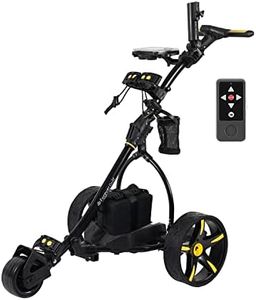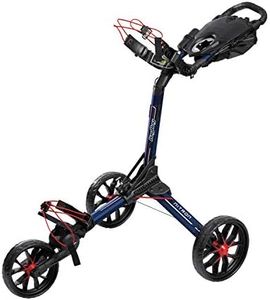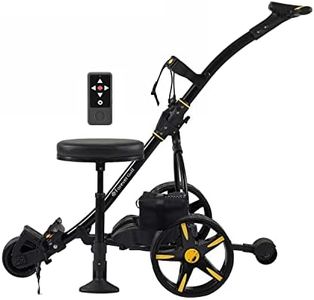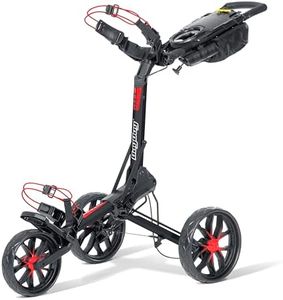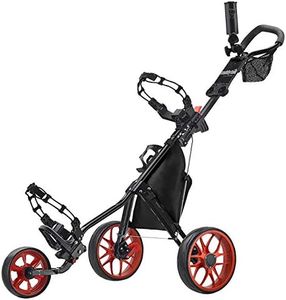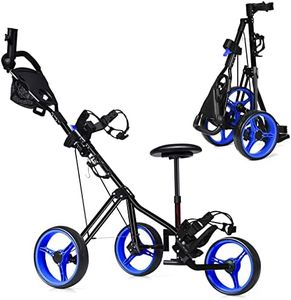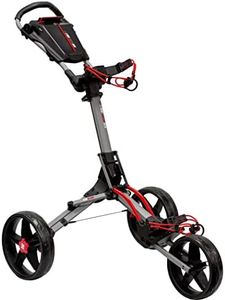We Use CookiesWe use cookies to enhance the security, performance,
functionality and for analytical and promotional activities. By continuing to browse this site you
are agreeing to our privacy policy
9 Best Electric Push Carts
From leading brands and best sellers available on the web.Buying Guide for the Best Electric Push Carts
Electric push carts can make transporting your items—often golf bags or groceries—much easier by using a battery-powered motor to push themselves. Choosing the right electric push cart will depend on your specific needs, such as the type of terrain you deal with, how much you need to carry, and how much space you have to store the cart when not in use. Understanding each important spec will help you narrow down your choices and make sure you get a model that suits your lifestyle and preferences.Battery LifeBattery life indicates how long the cart can operate before needing to be recharged. This spec is crucial because it determines whether the cart will last through your activities, such as a full round of golf or a long shopping trip. Battery life is usually described in hours of use or how many miles it can cover. Shorter battery lives (1-2 hours) may suit those who only need the cart for quick tasks, while medium ranges (2-4 hours) are great for average golf games or medium-size outings. Longer-lasting batteries (4+ hours) are best if you plan to be out all day without recharging options. To pick the right one, think about how long you’ll typically use the cart in one go and choose a model with a battery that covers your longest expected outing.
Motor PowerMotor power reflects how much force the motor can provide to move the cart and its load. It's usually measured in watts. A lower-powered motor (around 100-150 watts) works well for smooth surfaces and lighter loads, while more robust motors (200-300 watts or more) are best for rougher terrain or heavier cargo. Users who expect to operate on flat, even ground can opt for lower-powered motors, but if you’ll face hills, grass, or uneven ground, go for higher power to avoid getting stuck.
Weight CapacityWeight capacity tells you how much the cart can carry safely. This is important to avoid overloading and damaging the cart. Capacities can vary from lighter loads (30-50 pounds) for small or personal items, to heavier loads (over 75 pounds) for full golf bags or larger shopping hauls. Consider what you usually need to transport and choose a cart that can handle that weight with some buffer to spare.
ManeuverabilityManeuverability covers how easily the cart can move and turn, often influenced by wheel size, swivel features, and handle design. Some models have fixed wheels for stability, while others have front-wheel swiveling for sharper turns. If you plan to use your cart in tight spaces or need to make many turns, look for models with good maneuverability features; for mostly straight paths and stability, simpler wheel designs may suffice.
Foldability and StorageFoldability and storage refer to how easily the cart can be collapsed and stored when not in use. Some carts have a compact, one-step folding mechanism, while others may require more effort or result in a bigger folded size. If you have limited space at home or plan to transport the cart in your car trunk, a compact, easily foldable design is ideal. If space is plentiful and you don’t need to move the cart often, a larger size may be acceptable.
Controls and FeaturesControls and features include how you operate the cart (like remote controls, speed settings, or hand brakes) and any extra conveniences (such as cup holders, umbrellas, or storage compartments). Simpler controls may be best for those wanting straightforward operation, while advanced features suit users who appreciate extra comfort or need specific functions. Think about what would make your outings easier and choose a model that offers those features.
Build Quality and MaterialBuild quality and material refer to how sturdy the cart is and what it’s made of, such as steel, aluminum, or plastic. Sturdier materials and solid construction mean the cart will last longer and handle bumps or weather better. Lighter materials, like aluminum, make it easier to push and store but may be less durable than steel. Decide if you prioritize portability or long-term durability and pick accordingly.
